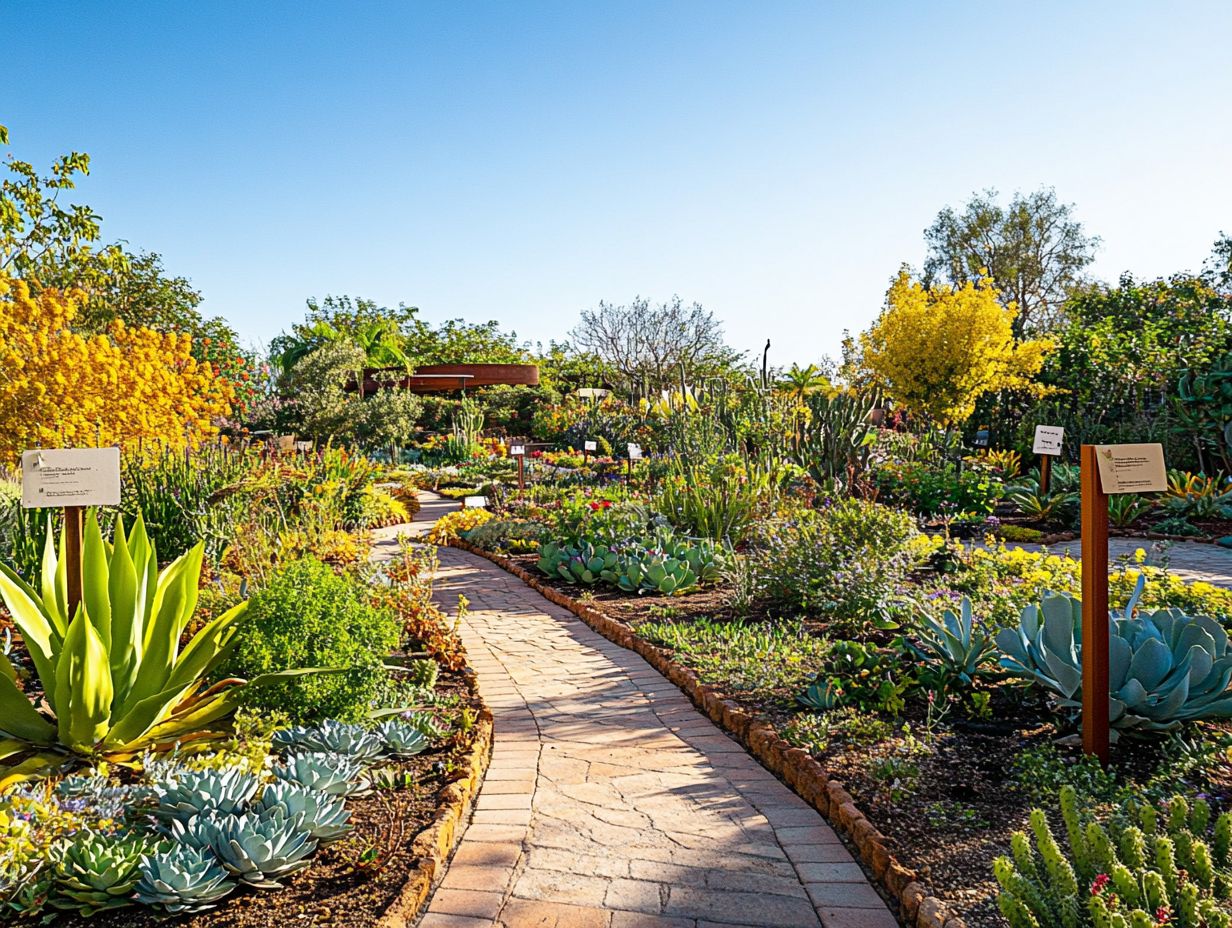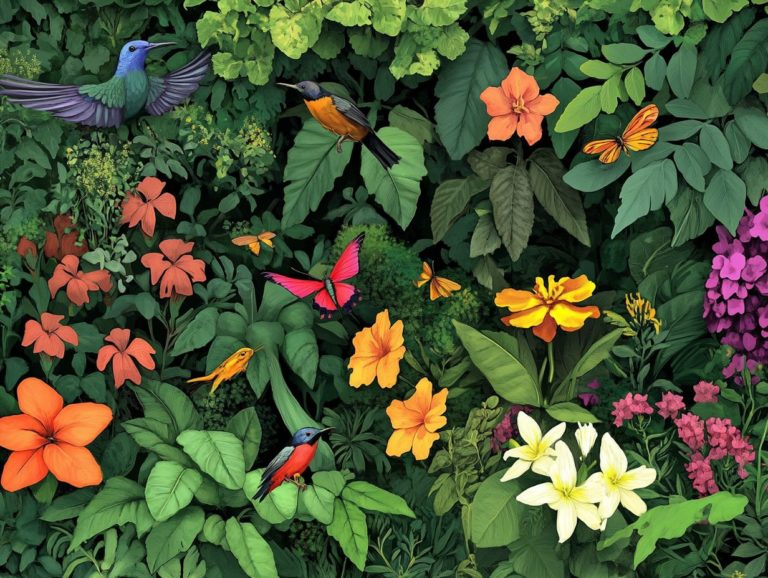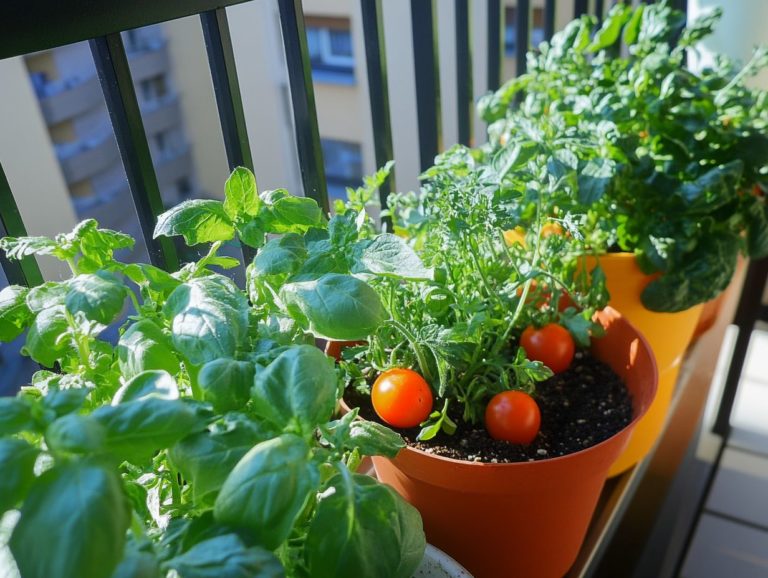“How to Select Plants for Different Climates”
Choosing the right plants for your garden can seem like an insurmountable task, particularly with the diverse climate zones you may encounter. Grasping the nuances of climate zones is vital for cultivating a thriving garden that flourishes throughout the year.
This guide meticulously outlines the different climate types, delves into the specific requirements of various plants, and provides practical tips to refine your gardening approach. By familiarizing yourself with the optimal plant selections for hot, dry climates compared to cool, wet ones, you can sidestep common pitfalls and ensure your garden thrives in perfect harmony with its environment.
Contents
- Key Takeaways:
- Understanding Climate Zones
- Factors to Consider when Choosing Plants
- Best Plants for Different Climates
- Adapting Plants to Different Climates
- Common Mistakes to Avoid
- Frequently Asked Questions
- What should I consider when selecting plants for different climates?
- How can I determine which plants are suitable for my local climate?
- What types of plants are best for hot and dry climates?
- Are there any plants that can survive in both hot and cold climates?
- How should I care for plants that are not native to my climate?
- Can I successfully grow plants that are not native to my climate?
Key Takeaways:

- Understand the climate zone you live in to select the right plants for your area.
- Consider climate requirements, soil, and sunlight needs when choosing plants.
- Adapt plants to different climates by adjusting care and avoiding common mistakes in plant selection.
Understanding Climate Zones
Understanding climate zones is essential for you as a gardener or horticultural enthusiast. These zones determine which plants can flourish under specific environmental conditions.
In areas such as Karnataka and Rajasthan, distinct climate zones exist. Each offers unique challenges and opportunities for cultivating vegetables, flowering plants, and fruits.
Familiarity with USDA hardiness zones can enable you to select species that are both native and adaptable. This promotes sustainability and resilience in your urban green spaces.
Defining Different Climates
Different climates are defined by parameters like temperature, humidity, and sunlight. These factors significantly influence urban vegetation and microclimate conditions in your garden.
Understanding these climatic variations is essential for any gardener aspiring to cultivate a thriving landscape. For instance, in tropical climates, warm temperatures and high humidity reign, allowing a diverse range of plant species to thrive. In contrast, temperate climates present distinct seasonal changes that can impact plant dormancy and growth cycles.
In arid climates, characterized by low precipitation and intense sunlight, biodiversity faces challenges. Here, gardeners often use a method called xeriscaping, which involves designing gardens to save water while keeping plants healthy. This highlights the adaptive strategies necessary for nurturing growth across various environmental conditions.
Factors to Consider when Choosing Plants
When choosing plants for your garden, consider several essential factors, such as climate requirements, soil composition, and the availability of sunlight and humidity.
A knowledgeable gardener recognizes how each of these elements influences plant growth and resilience. This is particularly true in varied environments like urban landscapes and different hardiness zones.
Taking the time to evaluate these aspects will pave the way for your dream garden to flourish!
Climate Requirements
Know your plants’ needs! Temperature and humidity are key to helping them grow strong. These factors dictate how well different species can adapt and thrive in their environments.
For example, tropical plants flourish in warm, humid conditions that mirror their natural habitats, where temperatures and moisture levels are consistently high. In contrast, many succulents and cacti, hailing from arid regions, thrive on significantly less humidity and can tolerate fluctuating temperatures.
This variation underscores the importance of tailoring your care strategies to meet the specific needs of each plant species. By closely monitoring local climate conditions and adjusting your watering schedules or indoor placements accordingly, you can better replicate these vital environmental factors. Ultimately, this encourages optimal growth and vibrant flowering.
Soil and Sunlight Needs

The soil and sunlight needs of your plants are crucial for their growth and health. Soil pH and nutrient availability are key factors for successful gardening.
Understanding your soil’s composition impacts nutrient availability. By checking soil acidity or alkalinity regularly, you can improve your garden’s health.
Adding compost enriches the soil and improves its structure. It’s also important to ensure your plants receive enough sunlight for optimal growth.
With this knowledge, you can cultivate a thriving garden!
Best Plants for Different Climates
Selecting the right plants for various climates requires knowing which species do well under specific conditions. Consider drought tolerance for dry areas or adaptability for cooler regions.
By making informed choices, your plants can thrive in their environments.
Plants for Hot and Dry Climates
Plants like cacti and other drought-tolerant species are essential for sustainable gardens. These resilient plants can withstand intense sunlight and infrequent rainfall.
For example, sedum and agave have thick leaves that store water. Herbs like rosemary and thyme are low-maintenance and add beauty and flavor.
By using heat-adapted plants, you can create stunning landscapes that reduce urban heat and enhance biodiversity.
Plants for Cool and Wet Climates
Choosing the right vegetables and flowering plants, such as Primrose and Wintergreen Boxwood, is vital for gardening success in cool, wet climates. Knowing which plants thrive enhances your garden’s aesthetics and productivity.
Leafy greens and root vegetables like kale and carrots do well in cool, damp conditions. Ornamental plants such as Astilbe and Japanese Iris add vibrant color.
Remember to consider soil drainage and sunlight exposure. Applying mulch retains moisture and prevents weeds for robust growth.
Incorporating native plants boosts sustainability and promotes environmental health, creating a haven for beauty and biodiversity.
Adapting Plants to Different Climates
Adapting plants to diverse climates means understanding their specific care needs. This knowledge helps them flourish in varied conditions.
By embracing this understanding, you can create a thriving oasis in any climate!
Tips for Adjusting Plant Care

Adjusting your plant care routine involves fine-tuning watering schedules, managing nutrients, and applying organic manure to enhance soil quality. Tailor these practices to your specific climate conditions.
Observe local weather patterns and seasonal changes. This helps you determine the best watering frequency and amount for healthy growth. In drier regions, your plants may benefit from deeper, less frequent watering sessions. This encourages robust root development.
In areas with higher humidity, more regular, lighter watering might be the key to preventing issues like root rot. To adapt your plant feeding practices, utilize soil checks to identify deficiencies. Provide your plants with the right fertilizers or organic amendments they need to thrive through varying weather patterns.
This thoughtful approach promotes vibrant health and abundant crops.
Common Mistakes to Avoid
By steering clear of common gardening missteps like choosing the wrong plants and overlooking climate factors you ll cultivate a flourishing ecosystem while avoiding potential pest and disease problems.
By avoiding these mistakes, you can create a vibrant garden that flourishes and thrives!
Issues with Improper Plant Selection
Improper plant selection can lead to stunted growth and increased vulnerability to pests and diseases, ultimately resulting in the failure of your garden.
Choosing species that struggle to thrive in your local climate means your hard work may start fading. For example, picking tropical plants for a temperate zone often results in lackluster performance, as these plants typically struggle with cooler temperatures or frost.
Choosing water-loving species in a drought area can quickly lead to their demise. The consequences extend beyond disappointment; they can also contribute to resource wastage and ecological imbalance. This highlights the importance of selecting plants that are suitable for your weather so make sure to choose wisely.
Finding the Right Plants for Your Climate
Finding the right plants for your climate starts with some research. Consider leaning toward native plants, as they are naturally better suited to your local conditions.
Understand the specific climate zones in your area. This knowledge helps you confidently select plants that will flourish with minimal fuss. Native species not only support local wildlife but also require less water and maintenance, making them a sustainable choice for your urban gardening endeavors.
Incorporating urban vegetation can transform your neighborhood s aesthetic while enhancing air quality. Explore local nurseries and consult with gardening experts to equip yourself with invaluable knowledge. This will enable you to cultivate a thriving garden that beautifully complements your local ecosystem.
Frequently Asked Questions
What should I consider when selecting plants for different climates?

Consider temperature, humidity, and rainfall when selecting plants for your climate.
How can I determine which plants are suitable for my local climate?
Research the hardiness zone of your region. Each plant is assigned a hardiness zone indicating the minimum temperature it can withstand. This will help you choose plants that can thrive in your specific climate.
What types of plants are best for hot and dry climates?
Plants that are best suited for hot and dry climates are drought-resistant and can withstand high temperatures. Examples include cacti, succulents, and Mediterranean herbs like rosemary and lavender.
Are there any plants that can survive in both hot and cold climates?
Yes! Some plants thrive in extreme temperatures. Evergreen trees like junipers and pines, along with perennial flowers such as coneflowers and black-eyed Susans, are great examples.
How should I care for plants that are not native to my climate?
Non-native plants often need extra attention. Learn their watering, sunlight, and nutrient needs, and shield them from harsh weather.
Can I successfully grow plants that are not native to my climate?
Yes, you can grow non-native plants! With careful planning and the right care, they can flourish in your garden. Choose plants that suit your local climate for the best results.






